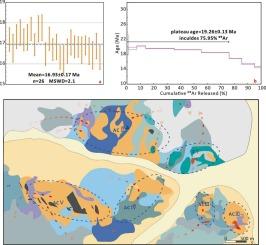Identification of the first high-sulfidation epithermal ore-bearing lithocap in the western section of the Gangdese metallogenic belt and its significance
IF 3.6
2区 地球科学
Q1 GEOLOGY
引用次数: 0
Abstract
Several lithocaps have been recently identified in the western section of the Gangdese metallogenic belt (GMB) and can be used to guide exploration of porphyry-high sulfidation epithermal deposits. In this work, we report the first ore-bearing lithocap (Mangla) within the GMB and carry out field mapping, geochronology, and shortwave infrared reflectance spectroscopy analyses. The zircon U-Pb (16.93 Ma) and alunite 40Ar-39Ar (19.24 Ma) isotope ages reveal that the protoliths and alteration of the Mangla lithocap occurred during one Cenozoic magmatic event, which corresponds with the mineralization ages of porphyry-skarn copper-polymetallic deposits in the eastern GMB. The alteration mineral assemblages, including alunite, dickite, pyrophyllite, kaolinite, and diaspore, along with enargite, colusite, Cu-S binary system minerals covellite and digenite, chalcopyrite and bornite, validate the characterization of a typical high-sulfidation epithermal mineralization system. Laterally, several alteration centers have been identified at the surface, and the vertical alteration is composed of deep high-temperature mineral assemblages (pyrophyllite + diaspore + topaz) that shift upward to low-temperature minerals, which are influenced primarily by faults, elevation, lithological permeability, fluid cooling and pH reduction. Notably, the vuggy quartz ± alunite and alunite + pyrophyllite zones within the lithocap are favorable locations for copper–gold mineralization, and a comprehensive epithermal mineralization system is preserved in this area, indicating the potential for underlying deep porphyry systems. Considering the presence of extensive continental volcanic coverage and notable analogous alteration features in the region, we assert that the area of Miocene continental volcanic rocks in northwestern Xizang presents substantial potential for copper–gold exploration.

冈底斯成矿带西段首个高硫化浅成热液含矿岩盖的识别及其意义
最近在冈底斯成矿带西段发现了几个岩性盖层,可用于指导斑岩高硫化浅成热液矿床的找矿。在这项工作中,我们报告了GMB内第一个含矿岩盖(Mangla),并进行了野外填图、地质年代学和短波红外反射光谱分析。锆石U-Pb (16.93 Ma)和明矾石40Ar-39Ar (19.24 Ma)同位素年龄表明,曼格拉岩盖原岩和蚀变发生在一次新生代岩浆事件中,与GMB东部斑岩-斯卡岩型铜多金属矿床的成矿年龄相对应。明矾石、迪辉石、叶蜡石、高岭石、一水硬铝石等蚀变矿物组合,以及辉铝石、泥铝石、Cu-S二元体系矿物银橄榄岩和辉铝石、黄铜矿和斑铜矿,验证了典型高硫化浅成热液矿化体系的特征。横向上,地表有多个蚀变中心,纵向蚀变主要受断裂、高程、岩性渗透率、流体冷却和pH还原等因素的影响,由深部高温矿物组合(叶叶石+一水硬石+黄玉)向上转移至低温矿物。岩盖内的孔洞石英±明矾石带和明矾石+叶蜡岩带是铜金矿化的有利部位,区内保存了完整的浅成热液成矿体系,预示着下伏深部斑岩体系的潜力。考虑到该地区存在广泛的陆相火山覆盖和明显的类似蚀变特征,认为西藏西北部中新世陆相火山岩区具有较大的铜金矿找矿潜力。
本文章由计算机程序翻译,如有差异,请以英文原文为准。
求助全文
约1分钟内获得全文
求助全文
来源期刊

Ore Geology Reviews
地学-地质学
CiteScore
6.50
自引率
27.30%
发文量
546
审稿时长
22.9 weeks
期刊介绍:
Ore Geology Reviews aims to familiarize all earth scientists with recent advances in a number of interconnected disciplines related to the study of, and search for, ore deposits. The reviews range from brief to longer contributions, but the journal preferentially publishes manuscripts that fill the niche between the commonly shorter journal articles and the comprehensive book coverages, and thus has a special appeal to many authors and readers.
 求助内容:
求助内容: 应助结果提醒方式:
应助结果提醒方式:


